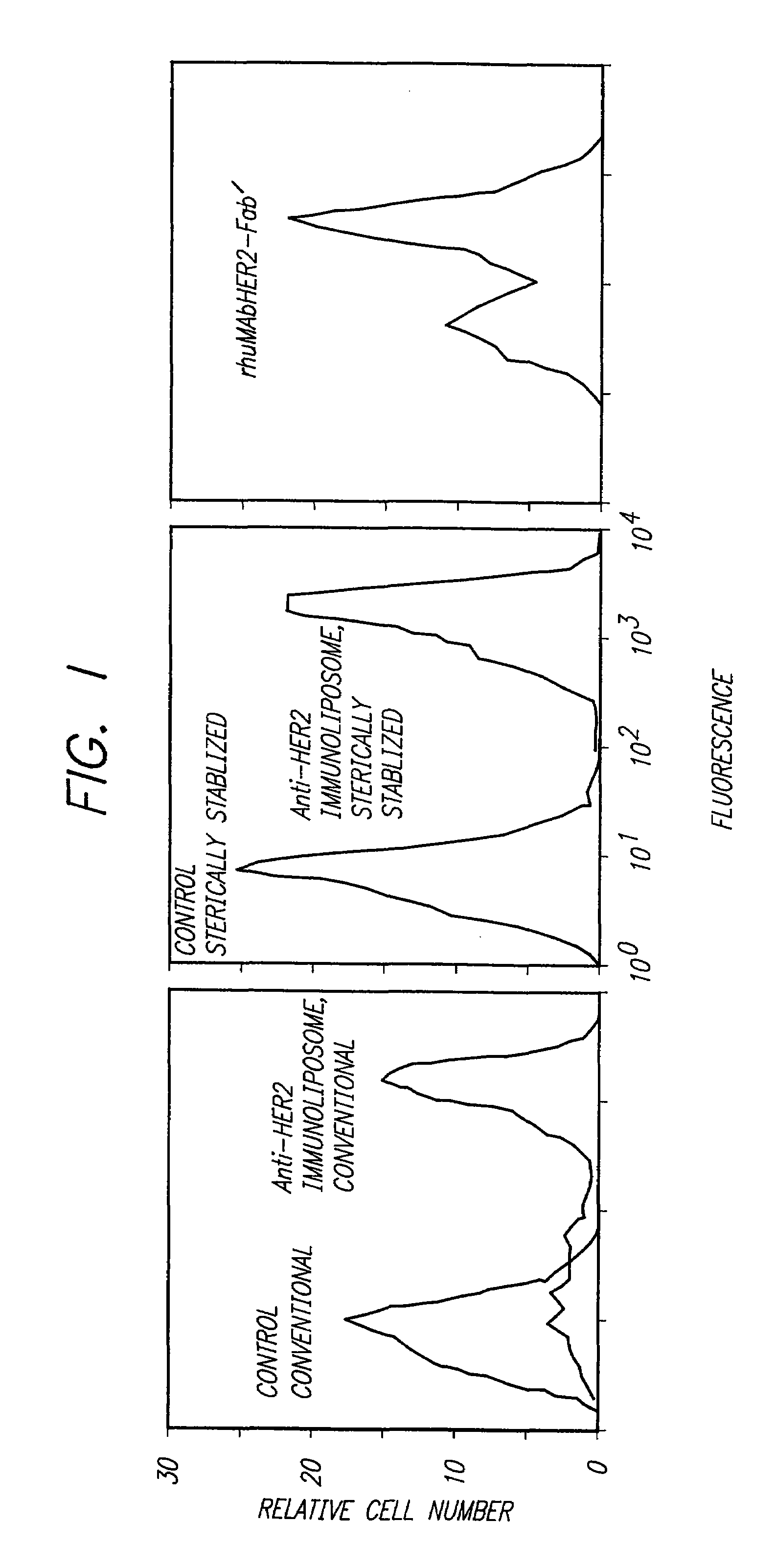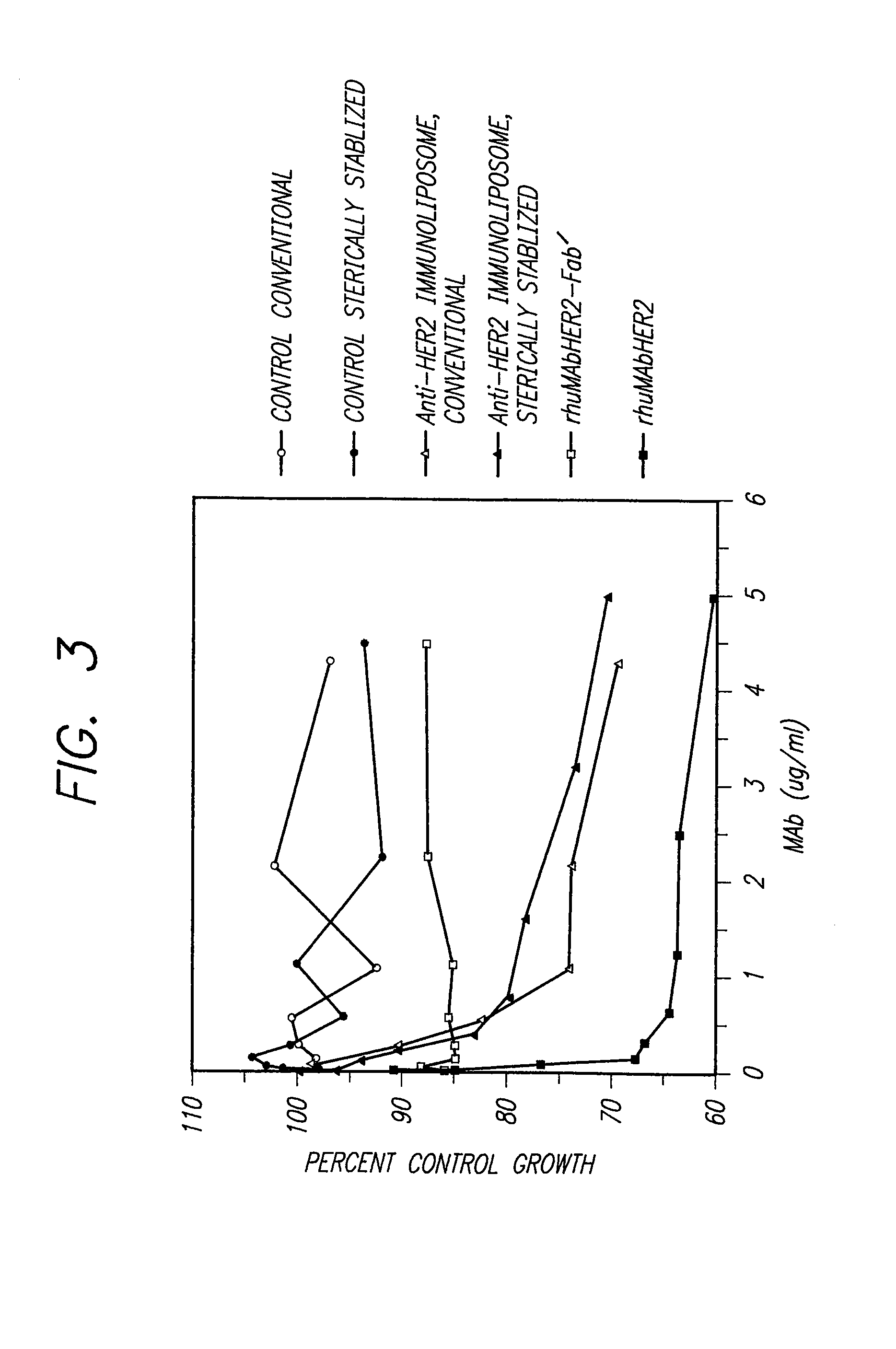Immunoliposomes that optimize internalization into target cells
a technology of oligosylated oligosylated cells and target cells, applied in the field of liposomes, can solve the problems of affecting the development of suitable clinical formulations, limiting the prospects of in vivo delivery systems, and affecting specific ligand recognition, so as to avoid the loss of therapeutic agents and increase the half-life of blood
- Summary
- Abstract
- Description
- Claims
- Application Information
AI Technical Summary
Benefits of technology
Problems solved by technology
Method used
Image
Examples
example 1
Preparation of Liposomes and Immunoliposomes
[0084]A) Materials
[0085]Egg phosphatidylcholine (EPC) was purchased from Avanti Polar Lipids (Alabaster, Ala.); cholesterol (Chol) from Calbiochem (San Diego, Calif.); N-Tris[hydroxymethyl]-2aminoethanesulfonic acid (TES) from Sigma; hydrogenated soy phosphatidylcholine (HSPC) from Natterman (Cologne, FRG); rhodamine-labeled phospholipids from Avanti; desferrioxamine mesylate (desferal) from Ciba-Geigy (Summit, N.J.); doxorubicin from Farmitalia, Carlo Erba (Milan, Italy) or Cetus (Emeryville, Calif.); and N-[4p-maleimidophenyl)butyryl]phosphatidylethanolamine (M-PE) from Molecular Probes (Portland, Oreg.). PEG (Mr=1900)-derivatized phosphatidylethanolamine (PEG-PE) was synthesized as described (Allen et al., Biochim. Biophys. Acta, 1066: 29–36 (1991)), and obtained from Liposome Technology, Inc. (Menlo Park, Calif.).
[0086]B) Preparation of Fab' Fragments.
[0087]Cloned rhuMAbHER2 sequences for heavy and light chain were co-expressed in E. c...
example 2
Immunoliposome Binding
[0092]The ability of anti-p185HER2 immunoliposomes to bind in vitro to breast cancer cells which overexpress the p185HER2 receptor was evaluated by two methods; a flow cytometric assay and a competitive binding assay. For the flow cytometric assay, SK-BR-3, which express high levels of p185HER2, or MCF-7 cells, were exposed to anti-p185HER2 immunoliposomes for 45 minutes on ice, washed with PBS, stained with a secondary anti-human antibody to detect bound immunoliposomes (FITC-labeled goat anti-human IgG), washed with PBS again, and then subjected to flow cytometry (FIG. 1). SK-BR-3 cells bound significant amounts of either conventional or sterically stabilized anti-p185HER2 immunoliposomes, but not control liposomes lacking Fab'. MCF-7 breast cancer cells, which do not overexpress p185HER2, showed minimal binding to anti-p185HER2 immunoliposomes (data not shown).
[0093]Another measure of binding was afforded by a competitive binding assay, in which SK-BR-3 (bre...
example 3
Anti-Proliferative Activity of “Growth-Inhibiting” Immunoliposomes
[0095]To test the antiproliferative activity of immunoliposomes alone, without encapsulated drugs, tumor cells such as SK-BR-3 or BT474 cells were grown in monolayer culture and then incubated at 37° C. with varying concentrations of immunoliposomes based on antibody content. After continuous treatment for 4 days, cell monolayers were washed with PBS and stained with crystal violet dye (0.5% in methanol) for determination of relative proliferation as previously described (Hudziak, et al., Mol. Cell Biol. 9: 1165–1172 (1989).
[0096]While intact (bivalent) rhuMAbHER2 inhibited the growth of p185HER2-overexpressing breast cancer cells in monolayer culture, monovalent Fab' fragments of this antibody (rhuMAbHER2-Fab') are much less effective at inhibiting growth (O'Connell et al. pages 218–239 In Protein Folding In Vivo and In Vitro., Cleland J L, ed. Washington, D.C., American Chemical Society, (1993)). This observation su...
PUM
| Property | Measurement | Unit |
|---|---|---|
| diameter | aaaaa | aaaaa |
| diameter | aaaaa | aaaaa |
| diameter | aaaaa | aaaaa |
Abstract
Description
Claims
Application Information
 Login to View More
Login to View More - R&D
- Intellectual Property
- Life Sciences
- Materials
- Tech Scout
- Unparalleled Data Quality
- Higher Quality Content
- 60% Fewer Hallucinations
Browse by: Latest US Patents, China's latest patents, Technical Efficacy Thesaurus, Application Domain, Technology Topic, Popular Technical Reports.
© 2025 PatSnap. All rights reserved.Legal|Privacy policy|Modern Slavery Act Transparency Statement|Sitemap|About US| Contact US: help@patsnap.com



